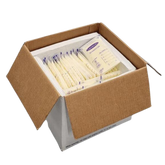You might have noticed social media featuring expectant mums coaxing a few shimmering drops of liquid gold into tiny syringes. That rich, antibody-packed fluid is colostrum, and your breasts start making it as early as the second trimester, but most mums only see it properly around the 36-week mark. From then on, a little intentional “collect-and-store” practice can pay off in spades when baby arrives.
Think of antenatal expressing as packing an emergency snack for your newborn: a quick 2 ml top-up can steady blood sugar, soothe first-day fussiness, and give you a reassuring “I've got this” moment while you're still finding your feet. In short, a few minutes of prep now can mean calmer, less frantic feeds tomorrow.

What Is Colostrum?
Colostrum is the initial milk your breasts produce from mid-pregnancy until roughly days 3–5 after birth. It is biologically designed to meet a newborn's needs in the first hours of life.
-
Colour & Texture: Colostrum is usually deep golden-yellow, thanks to beta-carotene, though perfectly normal shades range from pale straw to almost clear. Colostrum feels sticky, almost like runny honey.
-
Powerhouse Nutrients: brimming with immunoglobulins (your baby's first immune “vaccine”), double the protein of mature milk, and extra zinc, vitamin A, and growth factors to seal and protect a brand-new gut.
-
Volume: think teaspoons, not bottles, exactly the portion size a newborn's tummy can handle on day one.
When Does Colostrum Appear?
Your breasts actually begin making colostrum around mid-pregnancy, but most mums first notice droplets, often while showering or taking a bath, somewhere between 30 and 36 weeks. Because every drop is so concentrated, your baby needs only teaspoons at a time. Anything you collect antenatally stores well in the freezer – and later, if you'd rather save freezer space, it can be converted into a pantry-stable freeze-dried stash.
Benefits of Expressing Colostrum Before Birth
Expressing a few millilitres during the last weeks of pregnancy isn't just a social-media trend; it has well-documented perks for both you and your baby.

Why Bother Collecting Colostrum in Pregnancy?
-
Immediate nutrition on Day 0: A single 2ml syringe delivers concentrated energy and antibodies when bub is still practising the latch.
-
Kick-starts milk supply: Gentle hand expression primes your breasts, helping the transition to mature milk flow more smoothly.
-
Insurance for tricky feeds: Babies with tongue-tie, prematurity, or a sleepy latch can still get colostrum while you sort things out.
-
Gestational diabetes back-up: Stored colostrum can stabilise a newborn's blood sugar while you and the midwife fine-tune feeding.
-
Confidence boost for first-time mums: Seeing those golden drops builds trust in your body before the whirlwind of birth.
-
Smart prep for the newborn stage: On marathon evenings of cluster feeding, having a pre-collected syringe can spare your nipples, and perhaps your sanity.
-
Return-to-work planning: It also helps kick-start a solid stash for mums' return to work down the track.
Do I Have to Express Before Birth?
No, many mums go straight to skin-to-skin and direct breastfeeding without a single syringe in sight. But expressing is especially helpful if:
- you have gestational diabetes or are expecting a smaller baby
- there's a known tongue-tie or palate issue
- you're planning a caesarean and worry about a delayed first feed
- you simply want the reassurance of a back-up plan.
When Might Expressing Not Be Advised?
Skip antenatal expression or get the green light from your obstetrician first, if you have:
- placenta praevia or unexplained bleeding
- recurrent pre-term labour scares
- a history of cervical insufficiency or recent cervical stitch.
For every other mum, a relaxed five-minute hand-expression session once or twice a day from 36 weeks is safe, easy, and can make those first post-birth hours feel far less stressful.
Is Antenatal Expressing Safe?
For most healthy pregnancies, hand-expressing from 36–37 weeks is perfectly safe and won't “bring on” labour. The gentle breast stimulation involved is far milder than the oxytocin surge you'll get from everyday activities like nipple play in the shower or a warm cuddle with your partner. Still, a quick chat with your midwife or obstetrician is smart, especially if any of the situations below apply.
|
Check in with your care team first if you have… |
Why extra caution matters |
|
Placenta praevia or unexplained third-trimester bleeding |
Nipple stimulation could worsen bleeding. |
|
A history of pre-term labour or cervical insufficiency |
You're already at higher risk of early contractions. |
|
Multiple pregnancy (twins, triplets) with complications |
Uterine irritability is more common. |
|
Uncontrolled hypertension or pre-eclampsia |
Blood-pressure spikes need tight monitoring. |
|
Recent cervical cerclage (stitch) |
Extrauterine stimulation is best avoided. |
Quick rule of thumb: if your provider has ever advised you to avoid nipple stimulation or sex late in pregnancy, put antenatal expressing on hold until you get personalised guidance.
Otherwise, a relaxed five-minute session once or twice a day is unlikely to cause any issues, and many hospitals now teach hand expression in antenatal classes.
If you're also curious about the safety of turning those frozen syringes into pantry-stable powder later, our snapshot of the research behind freeze-drying breast milk lays out the data on how nutrients and antibodies stay intact.
When to Start Expressing Colostrum?

Most mums begin antenatal hand-expression somewhere between 36 and 37 weeks. By that point, your breasts are already producing colostrum, yet you're close enough to full term that a little nipple stimulation is considered safe in low-risk pregnancies.
-
Check in first: A quick thumbs-up from your midwife or GP is wise, particularly if you have placenta issues, multiples, pre-term labour scares, or any surgical stitches in place.
-
Ease in gently: Start with one five-minute session per day. If you're comfortable, you can move to two short sessions, morning and evening.
-
Listen to your body: Mild tightening (“Braxton Hicks”) is normal; painful cramping isn't. If anything feels off, stop and try again the next day, or call your care provider.
-
After birth: Keep the technique handy. Day-one newborns sometimes latch like champs; other times they nod off mid-feed. A quick hand-express top-up can bridge the gap, and you can gradually increase sessions to suit your baby's cues and your supply goals.
- Watch the clock, but loosely: There's no strict time limit. Think 5–7 rhythmic compressions, pause, rotate, repeat for about five minutes per breast. Over-pumping isn't helpful and can leave you sore.
Heads-up: If you're curious how these short antenatal sessions compare with full breastfeeding once bub is here, our guide on how long a breastfeeding session lasts offers realistic timelines for those early days.
By pencilling in these brief daily sessions now, you'll not only build a small safety stash but also master a skill that comes in handy for blocked ducts, engorgement, or any sleepy-latch days after birth.
How do I store colostrum safely?
Even a single teaspoon of colostrum is precious, so the goal is to catch every drop and keep it safe.
Step-by-Step Collostrum Collection
Your first choice as a mum collecting colostrum is a sterile 1–3ml syringe. It's perfect for those tiny antenatal volumes: simply angle the nozzle just under the nipple as droplets appear and ease back the plunger to draw them in. If your flow suddenly ramps up you can let the milk pool into a small sterile cup or spoon, then transfer it into a syringe or storage vial straight away.
Pro tip: express over a clean towel so if a droplet escapes, you can scoop it right back up. Smaller portions mean you only thaw what bub will actually finish – no heartbreaking waste of liquid gold.
How Long Can I Store Colostrum?

Storing colostrum, and later storing mature breast milk, at the right temperature for the right length of time protects its antibodies, vitamins, and live immune cells from breaking down. By following these guidelines, you can be confident that your colostrum delivers full nutritional power for your baby:
-
Room temperature (up to 26°C): Colostrum is safe at room temperature for about four hours.
-
Refrigerator (4°C or colder): Place syringes inside a clean, sealed container, and you're good for about four days.
-
Freezer (–18 °C or colder): Place colostrum syringes stand upright in a zip-lock bag and it’ll stay good for up to 12 months (although using them within six months is optimal).
Freeze-Drying Your Colostrum
Freezing is brilliant for short-term storage, but freezers fill up fast and don’t travel well. Freeze-drying removes moisture at ultra-low temperatures, locking in antibodies, protein, and flavour for up to three years on the pantry shelf. Independent studies show freeze-dried breast milk keeps its immune factors intact. No fear of power outages, moving house, or a road trip.
Did you know? You can freeze-dry colostrum with Nourishy, not just mature milk. Simply freeze your labelled syringes first, pop them in the courier kit, and we’ll turn those golden drops into shelf-stable powder that’s ready whenever your little one needs an immune boost.
- Shelf-stable security
- Lightweight & portable
- Nutrient preservation
Can Colostrum Help Older Babies?
Yes, the same antibodies that protect a newborn’s gut can give a nine-month-old a booster during teething, daycare germs, or a nasty winter virus. Many of the parents using Nourishy keep a freez-dried colostrum pouch in the medicine cabinet. One scoop in a sippy cup can soothe a toddler’s upset tummy better than most electrolyte drinks.
How Much Colostrum Does My Baby Need?
-
Before birth: Your first hand-expressing attempts may amount to little more than a glisten, which is totally normal. As your technique improves, most mums collect 2–10 mL per session, adding up to 2–20 ml per day during those final weeks.
-
Day 0 (birth to 24 hrs): Newborn tummies are marble-sized, so 2–10 ml per feed is perfect.
-
Day 1–2: Appetite grows; aim for 5–15 ml per feed.
-
Day 2–3: Expect around 15–30 ml per feed as supply and stomach capacity increase.
- Day 3–4: Volumes often jump to 30–60 ml per feed. This is also when colostrum gradually blends into mature milk.
Remember, these ranges are just guidelines, every baby's rhythm is unique. Follow your little one's hunger cues like rooting, tongue flicking, and turning their head side to side to spot when to feed before the tears.
How Often & How Much Should You Express?
-
Antenatally: One short session a day is plenty to start; bump to two if you're comfortable and supply allows.
- Post-birth: Hand-express after direct feeds if bub is sleepy, premature, or still learning to latch. A quick five-minute express can keep your breasts comfortable and provide top-ups if needed.
Volumes will look tiny compared with formula bottle markings, but colostrum is super-concentrated. Those teaspoons pack an immune-boosting, calorie-dense punch, exactly what a just-born stomach can handle.
Feeding Your Baby Expressed Colostrum

Safe Ways to Offer It
-
Syringe feeding – Place the tip just inside your baby's cheek and depress the plunger slowly, allowing them to swallow between tiny bursts.
-
Spoon or cup – Sit bub upright; touch the milk to their lip and let them lap it up. Great for pre-term babies or those still learning to latch.
- Finger-feeding – Slip a clean, gloved finger (pad side up) into baby's mouth, then thread a thin feeding tube along your finger, dripping colostrum as they suck. Helpful for practising suck-swallow-breathe coordination.
A single 5ml syringe can even settle a fussy newborn during the dreaded witching hour, giving you a breather while keeping breastfeeding on track.
Thawing & Warming Colostrum
- Thaw frozen syringes in the fridge or stand them in lukewarm water.
- Never microwave or boil, hot spots destroy antibodies and can burn baby.
- Once thawed, use within 24 hours and discard any leftovers.
Handled gently and stored properly, every drop of expressed colostrum becomes a powerful (and portable) dose of immunity for your little one.
Transitioning From Colostrum to Mature Milk
Around days 3 to 5 postpartum, most mums notice a shift. Their breasts feel fuller, milk looks creamier (often pearly white instead of gold), and feeds suddenly take on a “gulp-gulp” sound. This phase, sometimes called milk coming in, marks the gradual hand-off from colostrum to mature milk.
- Volume leap: Feeds may jump from 30ml to 60ml (or more) almost overnight.
- Colour change: Hints of yellow fade as beta-carotene levels drop.
- Breast sensations: Firmness, warmth, and even mild engorgement are common; cool compresses or gentle hand expression relieve pressure.
Keeping Supply (and Comfort) on Track
- Stick with the basics: Hand expression still works; you'll just see milk spray rather than drip.
- Introduce a pump if needed: If baby is sleepy, separated for any reason, or your breasts feel rock-solid, a hospital-grade pump can protect your supply. Start with short 10-minute sessions and adjust.
- Size up your containers: Switch from 3ml syringes to 30–60 mL storage bags or bottles to match the new volumes.
- Practice responsive feeding: Offer the breast whenever bub shows early cues; draining the breast signals your body to keep producing.
- Keep hand-expression skills handy: They're invaluable for a quick engorgement release, blocked-duct rescue, or discreet milk capture on the go.
With these tweaks, you'll glide from those potent teaspoons of colostrum to the steady, abundant flow of mature milk, keeping baby satisfied and your breasts comfortable along the way.
Frequently Asked Questions About Colostrum
Do I really need to express colostrum before my baby is born?
No, plenty of mums wait until birth. But collecting a small stash is handy if you have gestational diabetes, plan a caesarean, or just want extra peace of mind.
What is colostrum made of?
Mostly water, protein (including immune-rich antibodies), healthy fats, carbohydrates, vitamins A & E, zinc, and white blood cells.
What kind of nutrients are in colostrum?
Twice the protein of mature milk, higher sodium, chloride, and magnesium, plus prebiotics that seed a healthy gut.
What's the difference between colostrum and breast milk?
Colostrum is thicker, lower in volume, and super-concentrated with immune factors; mature milk is higher in lactose, lighter in colour, and produced in greater quantities.
What are the stages of breast milk?
Colostrum (birth–~day 3)
Transitional milk (~day 3–14)
Mature milk (from ~two weeks onward)
When does colostrum turn to milk?
Around day 3–5 postpartum, when hormonal shifts boost volume and change the colour to creamy white.
What makes colostrum turn into breast milk?
The delivery of the placenta drops progesterone levels, allowing prolactin and oxytocin to ramp up milk production.
Does leaking colostrum mean labour is close?
Not necessarily. Some mums leak from 28 weeks; others never leak. Labour timing is unrelated.
Can you express colostrum if you're pregnant?
Yes, after 36 weeks in an uncomplicated pregnancy and with your care provider's OK.
Can you pump colostrum?
You can, but hand expression is usually more effective for the small, sticky volumes before milk “comes in.”
How long do you have colostrum?
Typically, until day 3–5, when it blends into transitional milk.
What happens if you don't produce colostrum?
True colostrum absence is rare. More often, it's present but hard to express. If you're worried, work with a lactation consultant right away.







